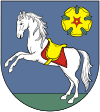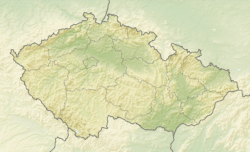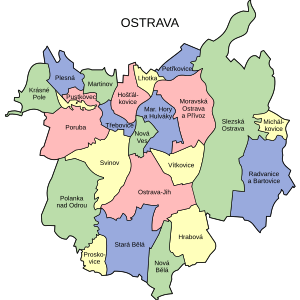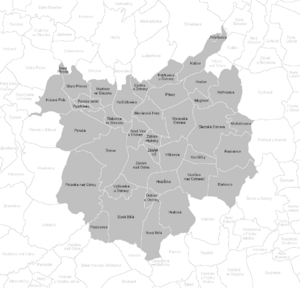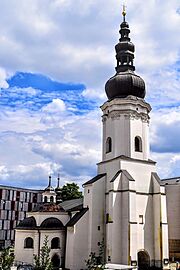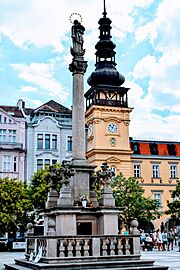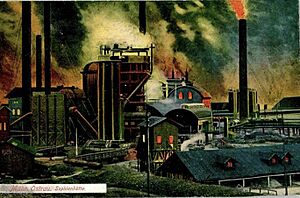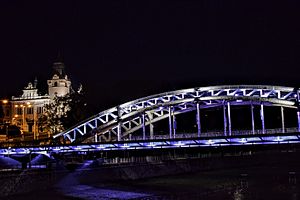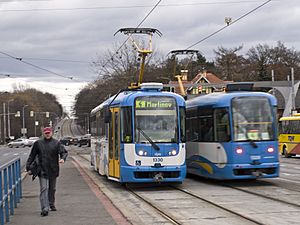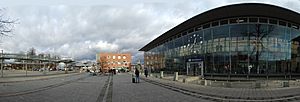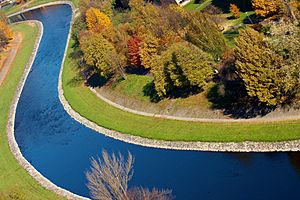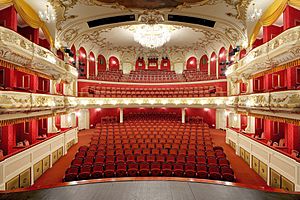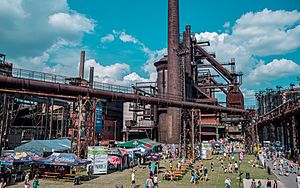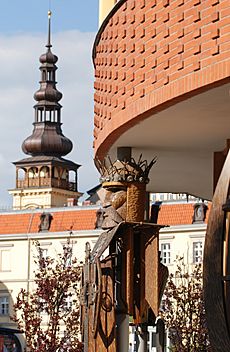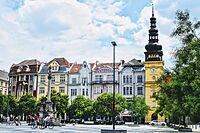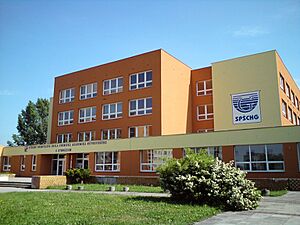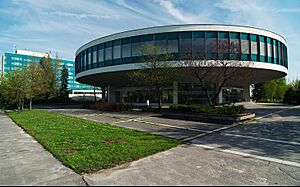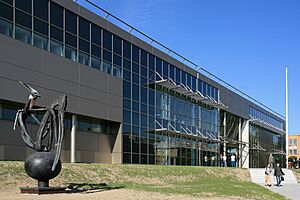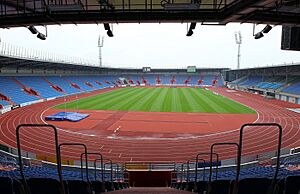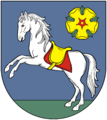Ostrava facts for kids
Quick facts for kids
Ostrava
|
|||||
|---|---|---|---|---|---|
|
Statutory city
|
|||||
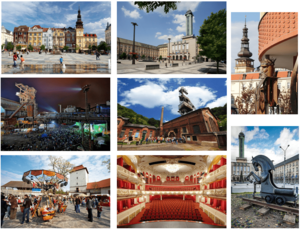
From top – Left: Masaryk Square, Colours of Ostrava, An amusement park in Silesian Ostrava Castle Middle: Ostrava New City Hall, Landek Park Mining Museum, Antonín Dvořák Theatre Right: Ostrava Puppet Theatre, Tribute to Mining statue
|
|||||
|
|||||
| Country | |||||
| Region | Moravian-Silesian | ||||
| District | Ostrava-City | ||||
| Founded | 1267 | ||||
| Area | |||||
| • Statutory city | 214.23 km2 (82.71 sq mi) | ||||
| Elevation | 260 m (850 ft) | ||||
| Population
(2024-01-01)
|
|||||
| • Statutory city | 284,765 | ||||
| • Density | 1,329.25/km2 (3,442.74/sq mi) | ||||
| • Metro | 982,000 | ||||
| GDP | |||||
| • Metro | €21.184 billion (2021) | ||||
| Time zone | UTC+1 (CET) | ||||
| • Summer (DST) | UTC+2 (CEST) | ||||
| Postal codes |
702 00, 703 00, 708 00, 709 00, 710 00, 711 00, 712 00, 713 00, 715 00, 716 00, 717 00, 719 00, 722 00, 723 00, 724 00, 725 25 – 725 28
|
||||
Ostrava is a big city in the north-east of the Czech Republic. It is the capital of the Moravian-Silesian Region. About 280,000 people live there. Ostrava is only 15 kilometers from the border with Poland. Four rivers meet in Ostrava: the Oder, Opava, Ostravice, and Lučina.
Ostrava is the third largest city in the Czech Republic by both population and size. It's the second largest city in the Moravia region. It is also the biggest city in the historical area of Czech Silesia. The city sits right on the border between Moravia and Silesia. The larger area around Ostrava, including towns like Bohumín and Havířov, has about 500,000 people. This makes it the biggest urban area in the Czech Republic, besides the capital city, Prague.
Ostrava became important because it was in the middle of a large coalfield. This made it a key industrial center for the Austrian empire. In the 20th century, it was known as the "steel heart" of Czechoslovakia. This was because it was a major center for coal mining and metal production.
After 1989, when communism ended, Ostrava changed a lot. Its industries were reorganized. The last coal was mined in the city in 1994. You can still see parts of the city's industrial past at Lower Vítkovice. This area used to be a place for coal mining, coke production, and ironworks. It still has its old industrial buildings. Lower Vítkovice is trying to become a UNESCO World Heritage List location.
Ostrava has many cultural places like theaters and art galleries. Many cultural and sports events happen there all year. These include the Colours of Ostrava music festival and NATO Days. Ostrava also has two public universities: the Technical University of Ostrava and the University of Ostrava. In 2014, Ostrava was named a European City of Sport. The city also helped host the Ice Hockey World Championships in 2004, 2015, and 2024.
Contents
- City Divisions: How Ostrava is Organized
- City Symbols and What They Mean
- Ostrava's Past: A Journey Through Time
- Ostrava's Location and Weather
- How People Live in Ostrava
- Getting Around Ostrava: Transport and Travel
- Ostrava's Environment: Challenges and Improvements
- Culture and Fun in Ostrava
- Places to See in Ostrava
- Learning in Ostrava: Schools and Universities
- Sports and Recreation in Ostrava
- Famous People from Ostrava
- City Leaders: Mayors of Ostrava
- Ostrava's Sister Cities
- Images for kids
- See also
City Divisions: How Ostrava is Organized
On September 14, 1990, Ostrava's city leaders decided to divide the city into 22 parts called boroughs. This started on November 24, 1990. On January 1, 1994, Plesná became its own separate borough. So, now the city has 23 boroughs. These boroughs are then split into 37 smaller administrative areas.
Here are the main boroughs:
- Hošťálkovice
- Hrabová
- Krásné Pole
- Lhotka
- Mariánské Hory a Hulváky
- Martinov
- Michálkovice
- Moravská Ostrava a Přívoz
- Nová Bělá
- Nová Ves
- Ostrava-Jih
- Petřkovice
- Plesná
- Polanka nad Odrou
- Poruba
- Proskovice
- Pustkovec
- Radvanice a Bartovice
- Slezská Ostrava
- Stará Bělá
- Svinov
- Třebovice
- Vítkovice
City Symbols and What They Mean
Ostrava's Coat of Arms
The city's coat of arms has a blue shield. On it, a silver horse stands on a green lawn. The horse has a golden saddle and a red blanket. In the top right corner, there is a golden rose with green leaves and a red center. The horse on the coat of arms does not have a bridle.
The oldest picture of this coat of arms is from a seal in 1426. The first colored version was made in 1728. The horse often represents Ostrava's location on an important trade route. It might also come from the coat of arms of Ostrava's first leader. The golden rose likely comes from the family coat of arms of Bishop Stanislav I Thurzo.
One story says the Bishop gave Ostrava the horse symbol to thank the town. Ostrava helped people from the Bishop's land in Hukvaldy when they were being attacked. The help came so fast that the attackers did not have time to put bridles on their horses before running away. Another legend says that during a siege, the townspeople let unbridled horses run around. This confused the attacking armies, and they left.
Ostrava's Marketing Logo
In 2008, Ostrava got a new marketing logo. It was designed by Studio Najbrt. The logo says "OSTRAVA!!!" and is used to promote the city. The three exclamation marks show that Ostrava and its people are dynamic, energetic, and confident. The light blue color of the city's name comes from old traditions. The exclamation marks are a darker blue to stand out.
Ostrava's Past: A Journey Through Time
The first time Slezská Ostrava was mentioned in writing was in 1229. It was described as a settlement. In 1267, Moravská Ostrava was first mentioned as a town. Ostrava grew along the banks of the Ostrá River, which is now called the Ostravice. The city got its name from this river. The river still divides the city into two main parts: Moravian Ostrava and Silesian Ostrava.
The settlement was in a very important spot. It was on the border between Moravia and Silesia. It was also on an old trade route called the Amber Road, which went from the Baltic Sea to the Adriatic Sea. This location helped the town grow and become successful.
However, Ostrava became less important after the Thirty Years' War. Danish forces took over in 1626. Swedish forces occupied the city from 1642 to 1650.
A big change for Ostrava happened in 1763. Large amounts of high-quality bituminous coal were found near the Ostravice River. In 1828, Rudolf Jan, the archbishop of Olomouc, owned the land. He started an ironworks named Rudolfshütte. Later, the Rothschild family bought the ironworks. It became known as the Vítkovice Ironworks. This company made Ostrava's industry grow very fast. By the mid-1900s, the city was called the country's "steel heart."
During World War II, Germany occupied the city. About 8,000 Jewish people from the Ostrava area were killed during this time. In 1994, a memorial was built in Milada Horáková Park to remember these victims.
After the war, many German-speaking people were asked to leave the city. This was part of the Potsdam Agreement. The city then grew a lot. New homes were built, first in the Poruba district. Later, large apartment blocks were built in the south of the city. The city center became less populated.
The 1990s saw a quick decline in Ostrava's main industries. These included iron, steel, chemicals, and coal mining. The last coal was mined on June 30, 1994. After this, a lot of money was spent to fix the environmental damage from years of heavy industry. These projects greatly improved the city's environment and the quality of life for its people. Ostrava became a popular place for tourists. It offered easy access to the nearby Hrubý Jeseník and Moravian-Silesian Beskids mountains.
Ostrava has many natural areas, including protected nature reserves. These include the Polanský Forest and Polanská Meadows. They are part of the Poodří nature reserve.
A special geological feature in the city is the granite erratic boulders. These rocks came from Scandinavia. They were left behind after the last ice sheets melted. Another interesting place is the Ema slag heap. This is a hill made of mining waste. It has its own special microclimate because the waste is still burning deep inside.
Ostrava's Location and Weather
Ostrava is about 270 kilometers east of Prague. It is mostly in the low-lying Ostrava Basin. Only the southwest part of the city extends into the Moravian Gate. Ostrava is mostly flat, with its highest point at 280 meters above sea level. The city is where four rivers meet: the Oder, Opava, Ostravice, and Lučina.
Ostrava is different from nearby areas because it has a lot of industry and many people. The Poodří Protected Landscape Area is in the southwest part of the city. Ostrava is 20.5 kilometers from north to south and 20.1 kilometers from east to west.
Ostrava's Climate
Ostrava has a climate with warm, humid summers and mild winters. The average yearly temperature is 10.2 °C. January is the coldest month, averaging -1.2 °C. July is the warmest, averaging 23.5 °C. The city gets about 580 mm of rain each year.
How People Live in Ostrava
Ostrava has seen its population change over time. In 1869, there were about 38,598 people. By 1900, the population grew to 144,550. The city continued to grow, reaching its highest population in 1991 with 327,371 people. As of 2021, the population was 282,450.
Getting Around Ostrava: Transport and Travel
Ostrava is a key place for transport in the north-east Czech Republic. It is close to the borders with Slovakia and Poland. The city has an airport and a highway nearby.
Air Travel
About 25 kilometers south of the city center is Leoš Janáček Airport Ostrava. This international airport connects Ostrava with several European cities. In 2015, it became the first airport in the Czech Republic to have its own train connection.
Roads
The main road in the region is the D1 motorway. This highway goes from Prague through Brno and Ostrava into Poland. Ostrava is 360 kilometers from Prague by motorway. It is 170 kilometers from Brno, 90 kilometers from Katowice in Poland, and 310 kilometers from Vienna. Other important roads also pass through Ostrava.
Public Transport
Ostrava has a good public transport system. It uses trams, buses, and trolleybuses. The first trams started in 1894 and were powered by steam. The tram network grew quickly. In 1901, it became electric. New tram lines were built mostly to the south and east of the city center.
Trolleybuses were added in 1952. At first, there was one trolleybus route around the city center. The network expanded in the 1950s and 60s. It replaced the older narrow-gauge railways. Today, Ostrava has 17 tram lines, 52 bus lines, and 14 trolleybus lines.
Train Travel
Ostrava is also a major train hub. It is on important railway lines and is a key center for cargo and passenger trains. These trains travel between the Czech Republic, Poland, and Slovakia. The city's biggest train stations are the main station (Ostrava hl.n.) and Ostrava-Svinov. These are important train junctions. Three train companies serve the main line connecting Ostrava with Olomouc, Pardubice, and Prague.
Ostrava's Environment: Challenges and Improvements
Ostrava's many heavy industries caused environmental problems, especially with air quality. Measurements show that levels of certain pollutants, like benzopyrene and dust, are very high in the city.
Even though Ostrava still has environmental issues, things have gotten better. In 2015, ArcelorMittal, a big polluter, invested a lot of money in projects to clean up. One new system filters out 61 tonnes of dust each year. The City of Ostrava also works on projects to improve the environment. They have a website where people can check air quality. They also fund short "health breaks" for children from areas with high pollution.
One big environmental problem is the oil lagoons at the old Ostramo chemical plant. In 1996, the Czech government took over the site to clean it up. The state-owned company Diamo was created for this.
Air quality in Ostrava is still a concern. Local people sometimes call it "Černá Ostrava" (Black Ostrava). There are even songs about it.
Culture and Fun in Ostrava
Performing Arts
Ostrava has four main theaters. These include the National Moravian-Silesian Theatre and the Ostrava Puppet Theatre. The Puppet Theatre hosts international festivals every year.
The Janáček Philharmonic Orchestra is based in Ostrava. The city also hosts several classical music festivals. Since 2002, Ostrava has held the annual Colours of Ostrava music festival. This festival features international artists and attracts thousands of people.
Other cultural events include film and theater festivals. There are also folklore festivals that celebrate traditions and crafts.
Museums and Galleries
Ostrava has many museums and galleries to explore:
- The Ostrava City Museum is in the Old City Hall. It shows the city's history and people.
- The Ostrava Science and Technology Centre is an interactive museum for all ages. You can try simulators for driving a train or flying a plane.
- The Toy Museum has toys from over 60 countries, some from the mid-1800s.
- The Railway Museum shows model trains and old documents.
- The Brewery Museum teaches about the history of making beer.
- The Firefighting Museum is in an old fire station. It shows firefighting tools and videos.
- Keltička's Forge Museum shows blacksmithing and coal mining history. A legend says a blacksmith named Keltička first found coal here.
- The Professor F. Pošepný Geology Pavilion has over 15,000 minerals, rocks, and fossils.
- The House of Art is a gallery for fine art.
- The PLATO (Ostrava City Gallery) shows modern Czech and international art.
- The Zither Museum has a collection of this musical instrument.
- The Mining Museum at Landek Park offers a tour of the old Anselm coal mine. You can go into a simulated mine tunnel.
- The Mill Museum focuses on mills in the Ostrava area.
- The Michal Colliery museum is in a former coal mine. You can follow the path miners took, but you can't go underground. It's a National Cultural Monument.
- Ostrava Planetárium is a place to learn about space.
Places to See in Ostrava
- Ostrava's New City Hall has the tallest tower of any city hall in the Czech Republic. From its viewing platform, 73 meters high, you can see the whole city.
- Komenského Gardens is a park in the city center. It has a statue honoring Soviet soldiers who helped free Ostrava in 1945.
- The Miniuni World of Miniatures has tiny versions of famous buildings. You can see the Pyramids, Eiffel Tower, and Big Ben.
- The fairytale clock at Ostrava's Puppet Theatre has figures that perform a show every two hours. It shows a fight between Kasper the clown and the Grim Reaper.
- The Silesian Ostrava Castle used to be on higher ground. But it has sunk 16 meters because of old mine tunnels underneath it. The castle hosts the Summer Shakespeare Festival.
- Stodolní Street is the city's entertainment area. It has over 60 bars, clubs, and restaurants.
- Masaryk Square is in Ostrava's old center. It has a plague column from 1702 and a statue of Saint Florian.
- The Karolina Triple Hall is a modern space next to a shopping mall. Old industrial buildings were turned into a venue for sports, entertainment, and culture.
- Ostrava Zoo is the second largest zoo in the Czech Republic. It has over 400 different animal species.
- Lower Vítkovice has an old blast furnace. You can take a glass elevator to the top for great views. Guided tours tell the history of Vítkovice.
- Ema slag-heap is an artificial hill made of mining waste. It's 315 meters high. It has a warm micro-climate because the waste inside is still burning. White smoke comes out of cracks, and flowers grow all year. You can hike to the top for panoramic views.
Architecture: Ostrava's Buildings
Ostrava has four special areas with important buildings. These are Moravská Ostrava (the historic center), Ostrava-Poruba, Ostrava-Přívoz, and Ostrava-Vítkovice. Many of Ostrava's old buildings are in the city center. These include theaters, banks, and department stores from the early 1900s, when Ostrava was growing fast.
Masaryk Square has the old city hall and a Marian plague column from 1702. Nearby, Smetanovo Square has the Antonín Dvořák Theatre. To the west, you can see grand bank buildings. To the north is the New City Hall with its tall viewing tower.
The city center also has two important churches: the 13th-century Church of St. Wenceslaus and the Cathedral of the Divine Saviour. The Cathedral is the second largest church in Moravia and Czech Silesia.
Poruba is a large district known for its 1950s Socialist realist architecture. These buildings were inspired by grand Soviet cities. The main entrance to Poruba has a large triumphal arch.
The Vítkovice district was once the center of the iron and steel industry. The company built homes and facilities for its workers. The old parts of the district have a unique style with red-brick buildings.
Other districts with special architecture include Přívoz with its beautiful Art Nouveau buildings. The Jubilee housing development in Hrabůvka was built for workers in the 1920s.
Churches in Ostrava
Ostrava has many churches, including:
- Lutheran Church of Christ
- Church of St. Anne
- Church of St. Bartholomew
- Church of Sts. Cyril and Methodius
- Church of St. John of Nepomuk
- Church of St. James the Great
- Church of St. Joseph (Slezská Ostrava)
- Church of St. Joseph (Ostrava)
- Church of St. Catherine
- Church of Christ the King
- Church of St. Nicholas
- Church of the Assumption of the Virgin Mary (Michálkovice)
- Church of the Assumption of the Virgin Mary (Třebovice)
- Church of the Visitation of the Virgin Mary
- Church of the Immaculate Conception of the Virgin Mary (Radvanice)
- Church of the Virgin Mary the Queen
- Church of the Virgin Mary the Queen of the Holy Rosary
- Church of St. Paul
- Cathedral of the Divine Saviour
- Church of the Immaculate Conception of the Virgin Mary (Přívoz)
- Church of St. Wenceslaus
Learning in Ostrava: Schools and Universities
Universities
Ostrava is home to several universities:
- VSB – Technical University of Ostrava
- University of Ostrava
- Business School Ostrava
- Katowice School of Economics, Ostrava faculty
- Newport International University, Ostrava branch
- Paneuropean University, Ostrava branch
Library
The Moravian-Silesian Research Library is in the town hall at Prokeš Square. It has a history and culture department.
Schools Teaching in Foreign Languages
- The Ostrava International School
- 1st International School of Ostrava
- Ostrčilova Bilingual School
- Hello s.r.o. – High School, Primary School and Nursery School
- Monty School – Primary School and Nursery School
- Hladnov High School and Language School, Slezská Ostrava
- Pavel Tigrid Foreign Languages High School, Ostrava-Poruba
- PORG Primary School and High School
Sports and Recreation in Ostrava
Ostrava has many sports clubs and has hosted big national and international sports events. In 2014, it was a European City of Sport. Ostrava has top sports teams like FC Baník Ostrava (football) and HC Vítkovice Steel (ice hockey).
The city has many sports facilities. These include athletics tracks, football fields, ice rinks, and swimming pools. The outdoor swimming pool in Ostrava-Poruba is the largest of its kind in Central Europe.
Ostrava is great for cycling because it's mostly flat. It has many bike paths. The nearby Beskids and Jeseníky Mountains are popular for skiing in winter. In other seasons, people go hiking, cycling, and fishing there. A special "cyclebus" takes bikes to the Beskydy Mountains from May to September. In winter, a "skibus" does the same for skiers.
There are also several golf courses in the region.
Ostrava has a long history of hosting major sports championships. The Golden Spike athletics meeting has been held every year since 1961. The Ostrava Marathon started in 1954. Ostrava also helped host the IIHF Ice Hockey World Championship in 2004, 2015, and 2024.
Famous People from Ostrava
Many notable people were born or lived in Ostrava:
- Max Winter (1903–1996), original owner of the Minnesota Vikings
- Stephan Körner (1913–2000), British philosopher
- Artur London (1915–1986), politician and author
- Vlastimil Brodský (1920–2002), actor
- Karel Reisz (1926–2002), British filmmaker
- Věra Chytilová (1929–2014), film director
- Yehuda Bacon (born 1929), Israeli artist
- Jaroslav Čejka (1936–2022), dancer, mime and actor
- Dieter F. Uchtdorf (born 1940), religious leader
- Hana Zagorová (1946–2022), singer-songwriter
- Karel Loprais (1949–2021), rally raid driver
- Jaromír Šindel (born 1959), ice hockey player
- Ivan Lendl (born 1960), tennis player
- Pavel Srníček (1968–2015), footballer
- Nikola Ristanovski (born 1969), Macedonian actor
- Petr Mrázek (born 1992), ice hockey player
- Klára Peslarová (born 1996), ice hockey player
City Leaders: Mayors of Ostrava
The first mayor of Moravian Ostrava was Hermann Zwierzina. Here are some of the mayors and other top city officials over the years:
- 1861–1864 Hermann Zwierzina
- 1864–1873 Alois Anderka
- 1873–1880 Konstantin Grünwald
- 1880–1888 Anton Lux
- 1888–1901 Adalbert Johanny
- 1901–1918 Gustav Fiedler
- 1918–1918 Johann Ulrich
- 1918–1935 Jan Prokeš
- 1935–1939 Josef Chalupník
- 1939–1940 Josef Hinner
- 1940–1945 Emil Beier
- 1945–1945 Josef Lampa
- 1945–1960 Josef Kotas
- 1960–1964 Jan Buchvaldek
- 1964–1968 Josef Kempný
- 1968–1971 Zdeněk Kupka
- 1971–1986 Eduard Foltýn
- 1986–1989 Bedřich Lipina
- 1989–1990 Lubomír Vejr
- 1990–1993 Jiří Smejkal
- 1993–2001 Evžen Tošenovský
- 2001–2002 Čestmír Vlček
- 2002–2006 Aleš Zedník
- 2006–2014 Petr Kajnar
- 2014– Tomáš Macura
Ostrava's Sister Cities
Ostrava is connected to other cities around the world as twin towns. This means they share cultural and economic ties.
 Abomey, Benin
Abomey, Benin Coventry, England, United Kingdom
Coventry, England, United Kingdom Dresden, Germany
Dresden, Germany Gaziantep, Turkey
Gaziantep, Turkey Katowice, Poland
Katowice, Poland Košice, Slovakia
Košice, Slovakia Miskolc, Hungary
Miskolc, Hungary Oral, Kazakhstan
Oral, Kazakhstan Piraeus, Greece
Piraeus, Greece Pittsburgh, United States
Pittsburgh, United States Shreveport, United States
Shreveport, United States Split, Croatia
Split, Croatia
Images for kids
See also
 In Spanish: Ostrava para niños
In Spanish: Ostrava para niños



